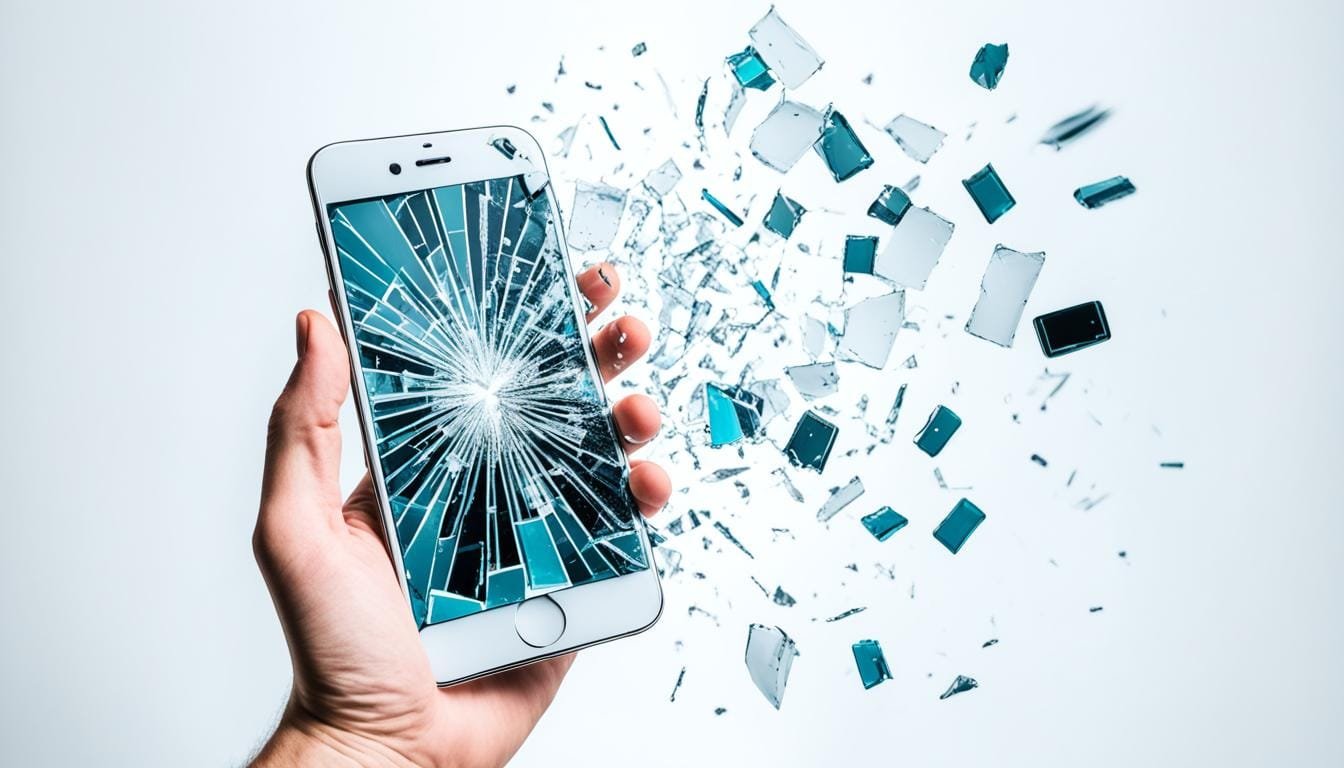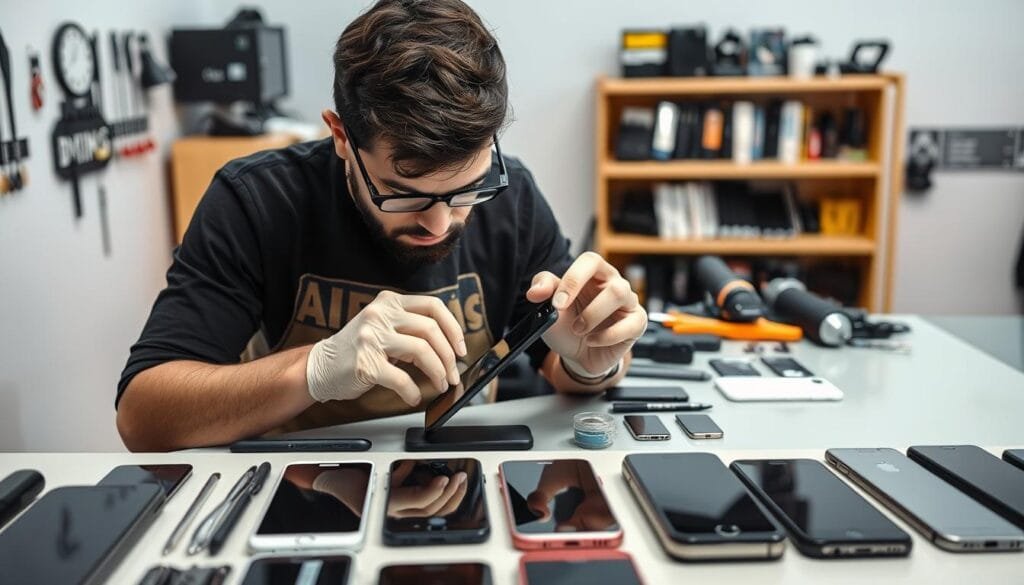How to Spot Internal Phone Damage | Expert Guide
October 16, 2024 | by search.wizards.info@gmail.com

How to Spot Internal Phone Damage | Expert Guide
Ever wondered if your phone has internal damage? With smartphones being so important for our daily lives, knowing the signs of damage is key. This guide will show you how to spot these signs early, helping you fix problems before they get worse.
Key Takeaways
- Learn how to identify visual cues of water damage and corrosion on your phone.
- Discover the hidden sentinels that signal liquid damage to internal components.
- Understand the symptoms of internal hardware failure, from erratic behavior to slow performance.
- Troubleshoot touchscreen and audio issues that may indicate deeper problems.
- Detect signs of charging and battery life anomalies that could point to component deterioration.
If your phone has been wet, dropped, or shows signs of aging, this guide can help. Waterproof phone pouches and quick action can save your phone from damage1.
Recognising the Signs of Internal Phone Damage
As smartphone owners, knowing the visual signs of internal damage is key. These signs can help us spot problems early, saving us from expensive repairs or needing a new phone.
Visual Cues: Water Markings and Corrosion
Water damage often shows as water marks or changes in the screen’s look2. You might see dried water stains or a different screen appearance. This means your phone has been wet. Also, corrosion near ports or the charging socket shows water got inside3.
Look out for the Liquid Damage Indicator (LDI), a small sensor that changes colour with water exposure. If it’s red or maroon, your phone has likely been damaged by water, even if it looks okay on the outside2.
| Visual Sign | Implication |
|---|---|
| Water markings behind the screen | Indicates the phone has been exposed to liquid |
| Corrosion around ports and charging socket | Suggests internal water damage and component corrosion |
| Discoloured Liquid Damage Indicator (LDI) | Confirms the phone has been in contact with water |
By watching for these signs, we can fix internal phone damage early. This helps stop further damage23.
Liquid Damage Indicators: The Hidden Sentinels
Checking if your phone has been exposed to liquid can be tricky. But, a secret way is to look for liquid damage indicators (LDIs). These small stickers or dots inside your phone change colour when they touch moisture. This shows your phone might have been wet4.
Most phones have LDIs near the battery, charging port, or SIM card slot. By looking at these spots, you can see if they’ve changed colour. This could mean your phone got wet4.
Learning to spot these indicators is key to keeping your phone safe. It helps you see if there are problems and what to do next, like fixing or replacing it4.
Checking the LDIs often and watching for other moisture signs keeps you ahead of any issues. This way, you can fix problems early and keep your phone working well4.
Knowing about these hidden signs helps you take good care of your phone. It keeps your device in top shape, protects your investment, and makes sure you have a reliable phone for a long time4.
How do you know if your phone has internal damage?
Finding out if your phone has internal damage can be hard. But, there are signs to look for. These include strange behavior, slow performance, and issues with the touchscreen or charging56.
Visible signs like water marks or corrosion inside the phone are clear warnings. If you see any discoloration or residue, it means your phone has been wet. This could lead to more problems.
Liquid damage can be subtle too. For example, the liquid damage indicator (LDI) might turn pink or red from white or silver6. If this happens, you should get help fast. Leaving a wet phone on can make things worse.
Random shutdowns, freezing, or slow performance are also signs of damage5. These problems might come from damaged parts inside the phone. You should check it out and maybe fix it.
Other signs include touchscreen issues, poor sound quality, charging problems, and fast battery use5. Seeing these signs means you should fix them quickly. This helps stop more damage and keeps your phone working right.
By watching for these signs, you can spot internal damage early. Then, you can fix it yourself or get professional help. Ignoring these signs can cause bigger, more expensive problems later.
Symptoms of Internal Hardware Failure
Our phones are a big part of our daily lives. It’s important to know the signs of internal hardware problems7. If the phone’s parts like the motherboard start to fail, you might see unexpected issues. These can include slow performance and strange behaviour.
Erratic Behaviour and Slow Performance
Internal hardware damage can cause apps to crash, random reboots, and slow performance7. These problems can happen if the phone gets water damage, overheats, or if repairs are done poorly7. If your phone keeps freezing, lagging, or shutting down, it’s a sign something’s wrong inside.
You might also find the touch screen is slow or not responding well8. This could mean the screen or connections inside are broken and need a pro to fix.
Discolouration, flickering, or a drop in display quality can also happen8. These signs suggest the screen or its parts might be damaged or corroded.
Also, your phone’s data could be at risk if the motherboard needs replacing7. This is because the data is stored on a chip on the motherboard. So, backing up your data regularly is crucial to avoid losing important memories and files.
By spotting these signs early, we can fix internal hardware problems quickly9. This helps keep our phones working well for longer. Early action and expert help are key to keeping your phone in top shape.
Troubleshooting Touchscreen and Audio Issues
If your phone has been damaged inside, you might face problems with the touchscreen and audio. A broken touchscreen can make it hard to use your device. Water damage or other internal problems can also mess with your phone’s speakers and microphone, leading to poor sound quality.
To fix these issues, follow these steps:
- Look for signs of water damage or corrosion, like discoloration or white marks. These signs suggest the inside might be damaged10.
- Use a diagnostic app like Phone Doctor Plus, Phone Check and Test, Zinny, or iDiagnosis to check your phone’s hardware and find any problems10.
- If the touchscreen isn’t working right, try fixing it or use different touch gestures to see if it’s a software glitch9.
- Make sure your phone has the latest software updates, which might fix touchscreen or audio issues9.
- If nothing works, you might need professional help or consider getting a new phone if the damage is too much9.
Fixing touchscreen and audio problems early can stop more damage and keep your phone working well. Being proactive and using the right tools can often fix these issues without needing a new phone.
“Addressing touchscreen and audio issues early on can prevent further damage and help you get the most out of your phone.”
Charging and Battery Life Anomalies
If your phone gets damaged from water, it can mess up how it charges and its battery life11. Phones often lose battery life as they get older, leading to unexpected shutdowns11. This could mean there’s internal damage that needs fixing to keep your phone safe11.
Issues with the battery can also make the touchscreen less sensitive or show strange lines on the screen11. Problems with the GPU or connectors might be the cause11. Software issues can cause connectivity problems and weird audio, making using your phone frustrating11.
To fix these problems, you need to find and fix the root cause quickly12. Bad charging habits, like letting the battery fully drain before charging, can shorten its life12. Faulty chargers or damaged charging ports can also cause issues and might need professional help12.
If hardware fixes don’t work, software glitches might be the issue12. Try restarting your device, updating its software, or doing a factory reset to fix charging problems12.
Fixing charging and battery life issues early is key to avoiding more damage and keeping your device healthy1112. By being careful and acting fast, you can keep your phone in top shape for a longer time1112.
Detecting Internal Component Deterioration
At https://gadgetkingsprs.com.au/trusted-phone-repair-experts-in-australia/, our experts spot signs of damage like discoloration or corrosion on the motherboard. Green or white spots on internal parts mean corrosion from moisture.13
Not all damage is visible from the outside. But, our team can spot these signs. Working with trusted phone repair experts in Australia, you can be sure your device gets a full check-up and any needed fixes.
Discolouration and Corrosion Signs
Discolouration or corrosion on the motherboard and parts inside is a big clue of damage. Water or moisture can make metal parts oxidise and break down over time.14
- Green or white spots on circuit boards and connectors mean corrosion.
- Discoloured or rusted parts suggest water damage and possible internal problems.
- Visible water stains or condensation inside the device show liquid got in.
If you see these signs, get your phone checked by a pro in Australia. This can stop more damage and keep your device working well.
“Fixing internal damage quickly helps your phone work better and saves you money on a new one.”
At https://gadgetkingsprs.com.au/trusted-phone-repair-experts-in-australia/, our skilled team can handle many internal phone problems, like water damage or component failures. Count on us for reliable and honest service to fix your device.13
Precautionary Measures for Water-Damaged Devices
If your phone has gotten wet, act fast to lessen damage15. Phones can get damaged by water, even if they’re water-resistant16. The type of water, like pool or sea water, affects how much damage your phone takes.
- Immediately remove the phone from the liquid and turn it off.
- Take off any parts you can, like the back cover or SIM card tray.
- Use a clean, dry cloth or paper towel to dry the phone gently.
- Let the phone and its parts air out in a well-ventilated spot for 24-48 hours16. The drying time can change based on the method used, like silica gel, rice, or a fan.
- Don’t use a blow dryer, as it can harm the phone’s plastic and circuitry16.
Water damage might not be covered by insurance, so these steps can help15. By doing this, you’re giving your phone a good chance to work again after getting wet.
Even with water-resistant ratings, phones aren’t safe from all liquid damage15. Quick action and correct drying can help your phone survive a water incident and work like new1516.
Conclusion
Recognising signs of internal phone damage is key to fixing the issue17. With more people using mobiles in Australia17, knowing how to spot and fix these problems is vital. Taking quick action and following the right steps can help fix a water-damaged phone18.
If the damage is severe, getting professional help is best to avoid more damage19. Places like GadgetFix in Santa Barbara offer quick and reliable repairs with quality parts at good prices19. Knowing how to spot internal damage and acting fast is crucial for keeping our phones working well.
Being careful and acting early can help prevent damage to our phones. By staying informed and getting expert advice when needed, our phones can stay reliable. Dealing with phone issues might be tricky, but with the right knowledge and help, we can keep our devices in great shape.
FAQ
What are the most common signs that my phone has internal damage?
Look out for visual signs like water marks or corrosion. Also, check for discolored liquid damage indicators. Other signs include erratic behavior and slow performance.
Also, watch for touchscreen and audio issues, charging and battery life problems, and visible deterioration of internal components.
How can I check if my phone has been exposed to water?
Most phones have liquid damage indicators (LDIs) that change color when wet. To check, look near the battery, charging port, or SIM card slot.
What are some common symptoms of internal hardware failure in phones?
Watch for unexpected app crashes, random reboots, and slow performance. These can mean internal hardware issues, often from water damage or other problems.
How can water damage affect my phone’s touchscreen and audio?
Water can make the touchscreen unresponsive or erratic. It can also make speakers and the microphone sound muffled or distorted.
What are the signs that my phone’s charging or battery is being affected by internal damage?
Signs include the device not charging properly or the battery draining fast. These suggest water damage has hit the charging port and battery.
How can I identify physical signs of internal damage on my phone?
Look for discoloration or corrosion on the motherboard and other internal parts. Green or white spots are clear signs of water damage.
What should I do if I accidentally get my phone wet?
If your phone gets wet, act fast. Remove it from the liquid and turn it off. Take off any parts you can, blot the phone to dry it.
Use a desiccant to soak up moisture. Let the phone dry for 24-48 hours before turning it on again.
Source Links
- How to know if there is internal damage while dropping your phone?
- Top 7 Signs Your Smartphone Needs Repair
- Signs of Motherboard Failure in Mobile Phones | Dr Boom
- Damp Buildings – Damp Indoor Spaces and Health
- Check for physical damage on your mobile device
- How to Fix Water Damage to a Phone | Dr Boom Communications
- How to Know If Phone Motherboard Is Damaged
- Warning Signs a Cellphone Screen Needs to be Replaced — Cell Phone 911 | Cell Phone Repair
- 10 Common Phone Problems, and Their Fixes
- How to Run Diagnostics on Your iPhone or Android Phone
- Signs Your Phone Needs a Repair: Why Professional Repair
- Phone Not Charging? Possible Causes And Solutions
- Improving detection of patient deterioration in the general hospital ward environment
- The 10 Most Common Causes of iPad Damage
- What are the signs of water damage on a phone?
- How to Fix a Water-Damaged Phone in 7 Steps – Panda Security
- Mobile device damage and the challenges to the modern investigator
- Common Causes of Phone Damage and Data Loss
- Most Common Types of Cell Phones & Screen Damages – GadgetFix
RELATED POSTS
View all



 Choose repair by clicking (book now)
Choose repair by clicking (book now)